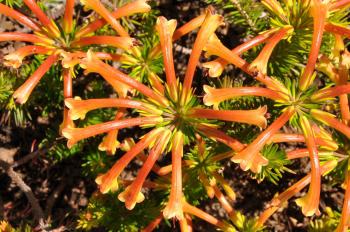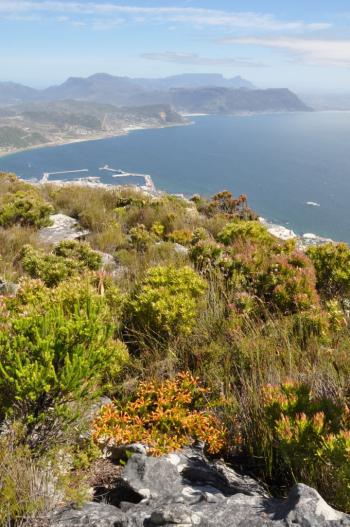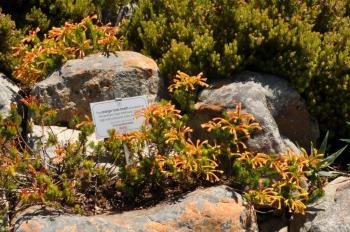Erica quadrisulcata
Erica quadrisulcata L.Bolus
Family: Ericaceae
Common names: orange rock-heath, Swartkop heath, four-groove heath
Introduction
A lovely fynbos shrub with bright golden-orange, curved, tubular flowers in showy heads at the tips of branches in mid-summer — ideal for a sunny rockery.

Description
Description
Erica quadrisulcata is an upright to sprawling shrub, 300-500mm tall. It has large, showy, tubular orange-yellow flowers in terminal umbels in mid-summer (December-February). The flowers are 20-35mm long, orange above and yellow below, curved, flared at the mouth, with four grooves at the base of the corolla tube. The anthers are included, meaning they do not protrude from the mouth of the corolla tube, and can be seen at the mouth. When in flower they are very eye-catching, but in the wild they are known to have seasons where few flowers are produced.

Erica quadrisulcata could be confused with Erica nevillei, the red rock-heath, but they can be distinguished from each other by the flower colour : E. quadrisulcata being orange and E. nevillei red. Furthermore, the anthers of E. quadrisulcata are included while in E. nevillei they protrude, and the flowers of E. nevillei are not produced in umbels but arranged spike-like.
Conservation Status
Status
Rare and endemic to the Cape Peninsula, Erica quadrisulcata occurs in a single population spread over an area of 12 sq.km. The population is stable and is protected, as it falls within the Table Mountain National Park.

Distribution and habitat
Distribution description
Erica quadrisulcata grows on rocky or sandy slopes and in rock crevices on the summits of the mountains southwest of Simonstown on the Cape Peninsula, including Swartkop and Klaasjaagersberg.
Derivation of name and historical aspects
History
The genus Erica gets its name from ereiko, to break, either because of the ability of the plant to break up bladder stones or more probably because the stems are brittle and break easily. This species is named for the four grooves at the base of the corolla, quadrisulcatus meaning with four grooves, from the Latin quadratus (squared, or in fours) and sulcatus (furrowed, from sulco to plough).

Ecology
Ecology
Erica quadrisulcata is most likely pollinated by sunbirds. In freshly opened flowers, the anthers are joined to form a ring around the stigma. This is broken by the bird's beak as it probes inside for the nectar at the base of the corolla tube. As the anthers separate, they dust pollen onto the beak of the bird, which transfers it to the next flower it visits. In a visited flower, the anthers are untidily scattered about the mouth of the tube.
Its rocky habitat probably offers it some protection from fires.
Uses
Use
Erica quadrisulcata is not used in traditional medicine, nor is it a candidate for the cutflower trade, but it shows promise as a garden ornamental, well suited to fynbos gardens and rockeries and is also suitable for pot cultivation.

Growing Erica quadrisulcata
Grow
Erica quadrisulcata needs a sunny position, in well-drained (sandy), acidic (pH 5-6.5) soil and is also suitable for containers. Mulch with well-rotted compost and keep root disturbance to a minimum. Grow it in the fynbos garden, Mediterranean garden, and in rockeries, retaining walls and on sandy slopes. It should cope well with windy coastal conditions.
Propagate by seeds or cuttings. Sow in late summer to autumn (March-May). Use a well-drained, acidic soil medium. Treat with Instant Smoke Plus Seed Primer to improve germination. The seeds are fine and need only a light covering. Water with a fine rose to avoid displacing the seeds. Germination takes 1-2 months. Transplant the seedlings when they are about 10mm high and grow on in light shade until they are established.
Take semi-hardwood heel cuttings in late summer to autumn or spring. Treat with rooting hormone and place in well-drained, well-aerated rooting medium in mist unit with bottom heat of ±24 o C. Pot the rooted cuttings in a well-drained, acidic soil medium and harden off in light shade for a month or two.
References
- Goldblatt, P. & Manning, J. 2000. Cape Plants, A Conspectus of the Cape Flora of South Africa . National Botanical Institute, Pretoria & Missouri Botanical Garden Press, Missouri.
- Oliver, I. & Oliver, T. 2000. Field Guide to the Ericas of the Cape Peninsula . National Botanical Institute, Cape Town.
- Schumann, D., Kirsten, G. & Oliver, E.G.H. 1992. Ericas of South Africa . Fernwood Press, Cape Town.
- Turner, R.C. 2007. Erica quadrisulcata L.Bolus. National Assessment: Red List of South African Plants version 2013.1. Accessed on 2014/01/02
Credits
Alice Notten
Kirstenbosch National Botanical Garden
January 2014
Plant Attributes:
Plant Type: Shrub
SA Distribution: Western Cape
Soil type: Sandy
Flowering season: Early Summer, Late Summer
PH: Acid
Flower colour: Yellow, Orange
Aspect: Full Sun
Gardening skill: Average
Special Features:
Horticultural zones









Rate this article
Article well written and informative
Rate this plant
Is this an interesting plant?
Login to add your Comment
Back to topNot registered yet? Click here to register.